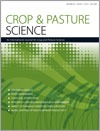Cullen australasicum is a legume species from Australia that holds promise for development as a drought-tolerant perennial pasture species, yet only a few accessions have been evaluated for agronomic traits. Several Cullen species aside from C. australasicum may also have potential for use as perennial pastures. We compared the field survival and aboveground biomass production of 100 germplasm accessions from 9 Cullen species, 2 lucerne (Medicago sativa) cultivars and 2 perennial Lotus species over 18 months in a low-rainfall region of the wheatbelt of Western Australia. Nutritive value of selected Cullen accessions was also compared with lucerne and L. australis. Several accessions of C. australasicum demonstrated good survival, productivity and nutritional value, and some accessions of C. discolor, C. lachnostachys, C. pallidum and C. pustulatum also showed promise in some or all of these traits. Significant phenotypic variation was seen among accessions of C. australasicum, C. pallidum, C. cinereum and C. tenax for some agronomic traits. We discuss the implications of this variation for further experiments or development of Cullen species. While survival and productivity of many Cullen accessions was similar to lucerne, only a few C. australasicum accessions were more productive than lucerne. We conclude that C. australasicum is currently the best prospect among Cullen species for cultivar development as a perennial pasture legume, and our analysis has highlighted accessions of particular interest. In addition, further work on C. discolor, C. lachnostachys, C. pallidum and C. pustulatum may also, in the longer term, provide useful pasture species.
How to translate text using browser tools
12 October 2012
Phenotypic variation for productivity and drought tolerance is widespread in germplasm collections of Australian Cullen species
R. G. Bennett,
T. D. Colmer,
D. Real,
M. Renton,
M. H. Ryan
ACCESS THE FULL ARTICLE

Crop and Pasture Science
Vol. 63 • No. 7
October 2012
Vol. 63 • No. 7
October 2012
Australian native plants
autumn feed gap
fodder plants
salinity
sustainable farming systems




